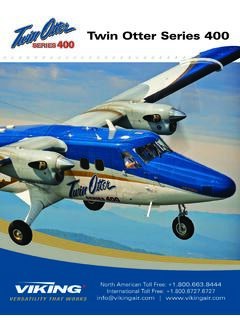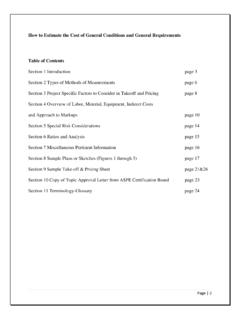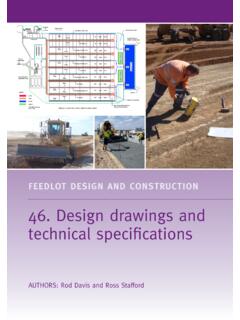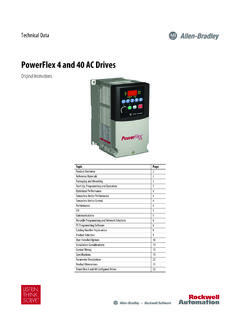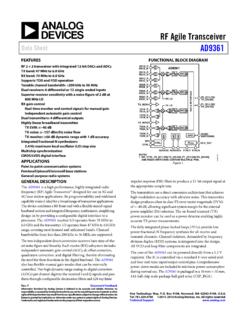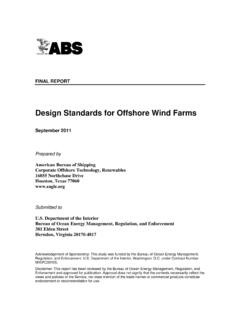Transcription of TECHNICAL SPECIFICATIONS & STANDARD EQUIPMENT LIST
1 TECHNICAL SPECIFICATIONS & STANDARD EQUIPMENT LIST TECHNICAL SPECIFICATIONS & STANDARD EQUIPMENT LIST Page 2 Note: Information contained within this report is proprietary to Viking Air Limited and provided for reference purpose only. Provision of this information does not constitute any form of contractual commitment between Viking Air Limited and the recipient. No warranty or representation is made to the accuracy or applicability of the information contained herein, and data is subject to change without notice. DOCUMENT REVISION: 01-18 Aircraft Overview The Viking DHC-6 Series 400 Twin Otter aircraft is an all-metal, high wing monoplane, powered by two wing-mounted turboprop engines, each driving a three-bladed, reversible pitch, fully feathering propeller.
2 The aircraft carries a pilot, co-pilot, and up to 19 passengers, depending upon the seating configuration. The Series 400 is an updated version of the Series 100, 200, and 300 Twin Otters. As with previous series updates, changes made have been selected to take advantage of newer technologies that permit more reliable and more economical operations. Aircraft dimensions, construction techniques, and primary structures have not changed. The aircraft is manufactured at Viking Air Limited facilities in Alberta and British Columbia, Canada. The type certificate (A-82 from Transport Canada) is held by Viking Air Limited.
3 The most significant change made to the Series 400 has been the introduction of a Honeywell Primus Apex integrated avionics suite. In addition to providing flat panel display of all flight instrumentation, the Apex suite also provides flat panel display of all engine parameters, all aircraft system parameters, all radio frequencies, the active flight plan, terrain and topography around the aircraft, weather radar, TCAS, and TAWS status. The flight compartment layout has been modernized, and all switches have been moved from the flight compartment roof to the sub-panels below each primary flight display.
4 Engines have been upgraded from the PT6A-27 to the PT6A-34. The engine continues to be flat rated to 620 horsepower, and all take-off and landing distances remain unchanged. Full flat rated take-off power from the PT6A-34 is available to ISA +27 C. A lightweight commuter interior is fitted as STANDARD . Interior and exterior lighting has been upgraded to LED or high intensity discharge (xenon) lighting. Cabin ventilation, heating, and optional air conditioning systems have been modernized. 1. general Description Aircraft Dimensions Overall Height 19 ft. 6 in ( m) Overall Length 51ft.
5 9 in ( m) Wing Span 65 ft. 0 in ( m) Horizontal Tail Span 20 ft. 8 in ( m) Cabin Dimensions Length 18 ft. 5 in ( m) Height 4 ft. 11 in ( m) Width 5 ft. 9 in ( m) Left Side cabin doors 50 in x 56 in ( m x m) Right side cabin door 30 in x 45 in ( x ) 2. Design Weights & Capacities Max. Takeoff Weight 12,500 lbs. (5,670 kg.) Max. Landing Weight 12,300 lbs. (5,579 kg.) Equipped Weight Empty 7,445 lbs. (3,377 kg.) Fuel Capacity US Gallons (1,419 l) Optional Long Range Fuel 89 US Gallons (337 l) TECHNICAL SPECIFICATIONS & STANDARD EQUIPMENT LIST Page 3 Note: Information contained within this report is proprietary to Viking Air Limited and provided for reference purpose only.
6 Provision of this information does not constitute any form of contractual commitment between Viking Air Limited and the recipient. No warranty or representation is made to the accuracy or applicability of the information contained herein, and data is subject to change without notice. DOCUMENT REVISION: 01-18 3. general Arrangement TECHNICAL SPECIFICATIONS & STANDARD EQUIPMENT LIST Page 4 Note: Information contained within this report is proprietary to Viking Air Limited and provided for reference purpose only. Provision of this information does not constitute any form of contractual commitment between Viking Air Limited and the recipient.
7 No warranty or representation is made to the accuracy or applicability of the information contained herein, and data is subject to change without notice. DOCUMENT REVISION: 01-18 4. Performance The following performance data is intended to demonstrate the aircraft's capability in a typical flight profile. STOL Takeoff and Landing Distances Takeoff dist. to 50 ft. ( m) 1,200 ft. (366 m) Landing dist. from 50 ft. ( m) 1,050 ft. (320 m) *Note: the use of short takeoff and landing capability of the aircraft is governed by local regulatory authority rules, regulations, and allowed procedures.
8 Specific approved procedures and related required safety factors (eg. Accelerate stop distances) may impact the achievable takeoff and landing distances. Potential operators should be aware of local requirements and consult the approved aircraft flight manual for performance data. SFAR 23 Takeoff and Landing Distances Takeoff dist. to 50 ft. ( m) 1,490 ft. (454 m) Landing dist. from 50 ft. ( m) 1,510 ft. (460 m) Accelerate Slow Distance to 35 kt 2,045 ft. (623 m) Accelerate - Stop Distance 2,220 ft. (675 m) Maximum Cruise Speeds, TAS Sea Level 170 kt 5000 ft. 181 kt 10,000 ft.
9 182 kt Enroute Rate of Climb at Sea Level Both engines at max climb power 1,600 One engine at max continuous power 340 Service Ceiling (Rate of Climb 100 ) Both engines max climb power 25,000 ft. (7,620 m) One engine max cont. power 11,600 ft. (3,536 m) Payload Range At Maximum Cruise Speed: Payload for 100 nm range 4,348 lbs. (1,972 kg) Payload for 250 nm range 3,828 lbs. (1,736 kg) Payload Range Continued Maximum Range (Zero Payload): With STANDARD tankage 763 nm (1,413 km) Maximum Range (Full Fuel & 2270 lbs. Payload): With STANDARD tankage 702 nm (1,300 km) Maximum Endurance: With STANDARD tankage hrs.
10 Performance Assumptions Used All takeoff distances are based on both engines operating at takeoff power throughout. The takeoff and landing distances are given at sea level, zero wind and from a dry concrete level surface. STOL landing distance assumes retardation with wheel brakes and both engines reversed. The CAR 3 and SFAR 23 landing distances and accelerate stop distance assume retardation with wheel brakes only. Payload range and maximum range data is based on the following assumptions: o Cruise at 10,000 ft. (3,048 m); o Fuel reserve for 45 minutes at cruise altitude and long range speed; and o Fuel consumption is based on engine manufacturer's SPECIFICATIONS .
